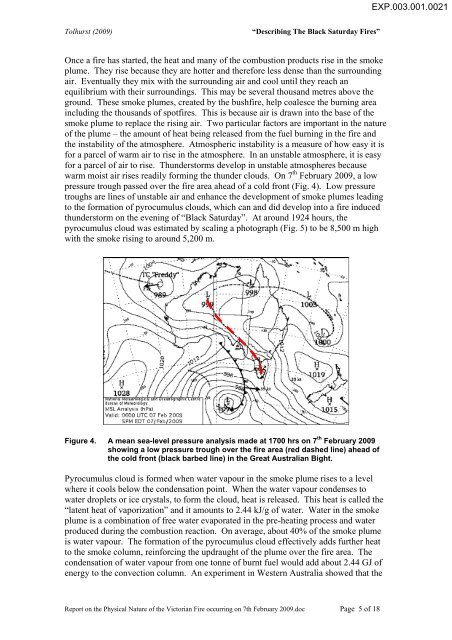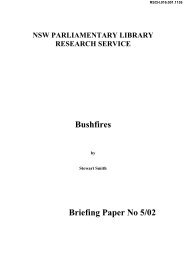Report on the Physical Nature of the Victorian Fires occurring on 7th ...
Report on the Physical Nature of the Victorian Fires occurring on 7th ...
Report on the Physical Nature of the Victorian Fires occurring on 7th ...
Create successful ePaper yourself
Turn your PDF publications into a flip-book with our unique Google optimized e-Paper software.
EXP.003.001.0021<br />
Tolhurst (2009)<br />
“Describing The Black Saturday <strong>Fires</strong>”<br />
Once a fire has started, <strong>the</strong> heat and many <strong>of</strong> <strong>the</strong> combusti<strong>on</strong> products rise in <strong>the</strong> smoke<br />
plume. They rise because <strong>the</strong>y are hotter and <strong>the</strong>refore less dense than <strong>the</strong> surrounding<br />
air. Eventually <strong>the</strong>y mix with <strong>the</strong> surrounding air and cool until <strong>the</strong>y reach an<br />
equilibrium with <strong>the</strong>ir surroundings. This may be several thousand metres above <strong>the</strong><br />
ground. These smoke plumes, created by <strong>the</strong> bushfire, help coalesce <strong>the</strong> burning area<br />
including <strong>the</strong> thousands <strong>of</strong> spotfires. This is because air is drawn into <strong>the</strong> base <strong>of</strong> <strong>the</strong><br />
smoke plume to replace <strong>the</strong> rising air. Two particular factors are important in <strong>the</strong> nature<br />
<strong>of</strong> <strong>the</strong> plume – <strong>the</strong> amount <strong>of</strong> heat being released from <strong>the</strong> fuel burning in <strong>the</strong> fire and<br />
<strong>the</strong> instability <strong>of</strong> <strong>the</strong> atmosphere. Atmospheric instability is a measure <strong>of</strong> how easy it is<br />
for a parcel <strong>of</strong> warm air to rise in <strong>the</strong> atmosphere. In an unstable atmosphere, it is easy<br />
for a parcel <strong>of</strong> air to rise. Thunderstorms develop in unstable atmospheres because<br />
warm moist air rises readily forming <strong>the</strong> thunder clouds. On 7 th February 2009, a low<br />
pressure trough passed over <strong>the</strong> fire area ahead <strong>of</strong> a cold fr<strong>on</strong>t (Fig. 4). Low pressure<br />
troughs are lines <strong>of</strong> unstable air and enhance <strong>the</strong> development <strong>of</strong> smoke plumes leading<br />
to <strong>the</strong> formati<strong>on</strong> <strong>of</strong> pyrocumulus clouds, which can and did develop into a fire induced<br />
thunderstorm <strong>on</strong> <strong>the</strong> evening <strong>of</strong> “Black Saturday”. At around 1924 hours, <strong>the</strong><br />
pyrocumulus cloud was estimated by scaling a photograph (Fig. 5) to be 8,500 m high<br />
with <strong>the</strong> smoke rising to around 5,200 m.<br />
Figure 4. A mean sea-level pressure analysis made at 1700 hrs <strong>on</strong> 7 th February 2009<br />
showing a low pressure trough over <strong>the</strong> fire area (red dashed line) ahead <strong>of</strong><br />
<strong>the</strong> cold fr<strong>on</strong>t (black barbed line) in <strong>the</strong> Great Australian Bight.<br />
Pyrocumulus cloud is formed when water vapour in <strong>the</strong> smoke plume rises to a level<br />
where it cools below <strong>the</strong> c<strong>on</strong>densati<strong>on</strong> point. When <strong>the</strong> water vapour c<strong>on</strong>denses to<br />
water droplets or ice crystals, to form <strong>the</strong> cloud, heat is released. This heat is called <strong>the</strong><br />
“latent heat <strong>of</strong> vaporizati<strong>on</strong>” and it amounts to 2.44 kJ/g <strong>of</strong> water. Water in <strong>the</strong> smoke<br />
plume is a combinati<strong>on</strong> <strong>of</strong> free water evaporated in <strong>the</strong> pre-heating process and water<br />
produced during <strong>the</strong> combusti<strong>on</strong> reacti<strong>on</strong>. On average, about 40% <strong>of</strong> <strong>the</strong> smoke plume<br />
is water vapour. The formati<strong>on</strong> <strong>of</strong> <strong>the</strong> pyrocumulus cloud effectively adds fur<strong>the</strong>r heat<br />
to <strong>the</strong> smoke column, reinforcing <strong>the</strong> updraught <strong>of</strong> <strong>the</strong> plume over <strong>the</strong> fire area. The<br />
c<strong>on</strong>densati<strong>on</strong> <strong>of</strong> water vapour from <strong>on</strong>e t<strong>on</strong>ne <strong>of</strong> burnt fuel would add about 2.44 GJ <strong>of</strong><br />
energy to <strong>the</strong> c<strong>on</strong>vecti<strong>on</strong> column. An experiment in Western Australia showed that <strong>the</strong><br />
<str<strong>on</strong>g>Report</str<strong>on</strong>g> <strong>on</strong> <strong>the</strong> <strong>Physical</strong> <strong>Nature</strong> <strong>of</strong> <strong>the</strong> <strong>Victorian</strong> Fire <strong>occurring</strong> <strong>on</strong> <strong>7th</strong> February 2009.doc Page 5 <strong>of</strong> 18

















